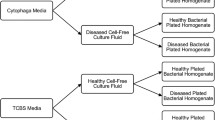Abstract
Mechanical stress on the coral Pocillopora damicornis caused the release of material that killed the coral pathogen Vibrio coralliilyticus. The bactericidal material was released into the surrounding seawater rapidly, reaching a maximum killing activity within 1 min of the stress. The coral antibacterial activity, referred to as CAA, was retained following filter sterilization and storage at −20°C. Exposure of V. coralliilyticus to CAA for 30 s, 1 min and 6 min resulted in the death of 82%, 89% and 99% of the bacteria, respectively. Release of CAA following mechanical stress was also observed with four other coral species tested. P. damicornis CAA was bactericidal to a wide variety of Gram-negative and Gram-positive bacteria. This is the first report that hard corals rapidly release fast-acting bactericidal material following mechanical stress. The release of CAA was demonstrated with both aquarium corals and corals taken directly from the sea. It is suggested that CAA is part of hard corals’ host defense system against infection, the natural stimulation for release of CAAs being the bite of a predator. Previous failures to detect antibacterial activity in hard corals can be attributed to a lack of understanding of the sensitive mechanism by which they are released.




Similar content being viewed by others
References
Amade P, Charroin C, Baby C, Vacelet J (1987) Antimicrobial activities of marine sponges from the Mediterranean Sea. Mar Biol 94:271–275
Anderson RM, May RM (1979) Population biology of infectious diseases. Nature 280:367
Anderson RM, May RM (1991) Infectious diseases of humans: dynamics and control. Oxford University Press, Oxford
Banin E, Israely T, Kushmaro A, Loya L, Orr E, Rosenberg E (2000) Penetration of the coral-bleaching bacterium Vibrio shiloi into Oculina patagonica. Appl Environ Microbiol 66:3031–3036
Ben-Haim Y, Rosenberg E (2002) A novel Vibrio sp. pathogen of the coral Pocillopora damicornis. Mar Biol 141:47–55
Ben-Haim Y, Zicherman-Keren M, Rosenberg E (2003a) Temperature-regulated bleaching and lysis of the coral Pocillopora damicornis by the novel pathogen Vibrio coralliilyticus. Appl Environ Microbiol 69:4236–4242
Ben-Haim Y, Thompson FL, Thompson CC, Cnockaert MC, Hoste B, Swings J, Rosenberg E (2003b) Vibrio coralliilyticus sp. nov., a temperature-dependent pathogen of the coral Pocillopora damicornis. Int J Syst Evol Microsc 53:309–315
Denner EB, Smith GW, Busse HJ, Schumann P, Narzt T, Polson SW, Lubitz W, Richardson LL (2003) Aurantimonas coralicida gen. nov. sp. nov., the causative agent of white plague II on Caribbean scleractinian corals. Int J Syst Evol Microbiol 53:1115–1122
Geiser DM, Taylor JW, Ritchie KB, Smith GW (1998) Cause of sea fan death in the West Indies. Nature 394:137–138
Green EP, Bruckner AW (2000) The significance of coral disease epizootiology for coral reef conservation. Biol Conserv 96:347–361
Jensen PR, Harvell CD, Wirtz K, Fenical W (1996) Antimicrobial activity of extracts of Caribbean gorgonian corals. Mar Biol 125:411–419
Kelman D (2004) Antimicrobial activity of sponges and corals. In: Rosenberg E, Loya Y (eds) Coral health and disease. , Springer, Berlin Heidelberg New York, pp 243–258
Kelman D, Kushmaro A, Loya Y, Kashman Y, Benayahu Y (1998) Antimicrobial activity of a Red Sea soft coral, Parerythropodium fulvum fulvum: reproductive and developmental considerations. Mar Ecol Prog Ser 169:87–95
Kim K (1994) Antimicrobial activity in gorgonian corals (Coelenterata, Octocorallia). Coral Reefs 13:75–80
Koh EGL (1997) Do scleractinian corals engage in chemical warfare against microbes? J Chem Ecol 23:379–398
Kushmaro A, Loya Y, Fine M, Rosenberg E (1996) Bacterial infection and coral bleaching. Nature 380:396
Kushmaro A, Rosenberg E, Fine M, Loya Y (1997) Bleaching of the coral Oculina patagonica by Vibrio AK-1. Mar Ecol Prog Ser 147:159–165
Loya Y, Sakai K, Yamazato K, Nakano Y, Sambali H, van Woesik R (2001) Coral bleaching: the winners and losers. Ecol Lett 4:122–131
Monks NR, Lerner C, Henriques AT, Farias SM, Schapoval EES, Suyenaga ES, da Rocha AB, Schwartzmann G, Mothes B (2002) Anticancer, antichemotactic and antimicrobial activities of marine sponges collected off the coast of Santa Catarina, southern Brazil. J Exp Mar Biol Ecol 2:1–12
Mullen KM, Peters EC, Harvell CD (2004) Coral resistance to disease. In: Rosenberg E, Loya Y (eds) Coral health and disease. Springer, Berlin Heidelberg New York, pp 377–399
Patterson KL, Porter JW, Ritchie KB, Polson SW, Mueller E, Peters EC, Santavy DL, Smith GW (2002) The etiology of white pox, a lethal disease of the Caribbean elkhorn coral Acropora palmata. Proc Natl Acad Sci USA 99:8725–8730
Richardson LL (1998) Coral diseases: what is really known? Trends Ecol Conserv 13:438–443
Rosenberg E, Ben-Haim Y (2002) Microbial diseases of corals and global warming. Environ Microbiol 4:318–326
Slattery M, McClintock JB, Heine JN (1995) Chemical defenses in Antarctic soft corals: evidence for antifouling compounds. J Exp Mar Biol Ecol 190:61–77
Sussman M, Loya Y, Fine M, Rosenberg E (2003) The marine fireworm Hermodice carunculata is a winter reservior and spring–summer vector for the coral-bleaching pathogen Vibrio shiloi. Environ Microbiol 5:250–255
Acknowledgements
We thank Y. Barash, R. Rozenberg, and O. Koren for assistance in obtaining and maintaining the corals. This research was funded by the Israel Centre for the Study of Emerging Diseases.
Author information
Authors and Affiliations
Corresponding author
Additional information
Communicated by M. Kühl, Helsingør
Rights and permissions
About this article
Cite this article
Geffen, Y., Rosenberg, E. Stress-induced rapid release of antibacterials by scleractinian corals. Marine Biology 146, 931–935 (2005). https://doi.org/10.1007/s00227-004-1505-5
Received:
Accepted:
Published:
Issue Date:
DOI: https://doi.org/10.1007/s00227-004-1505-5




